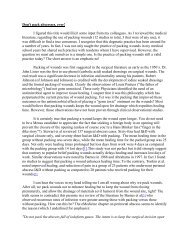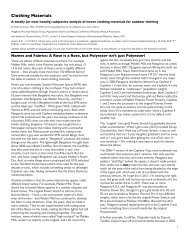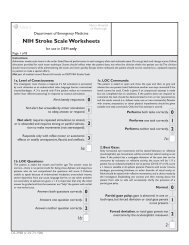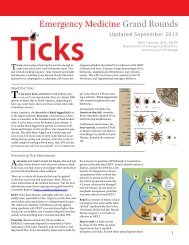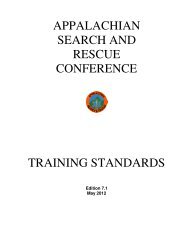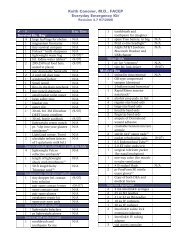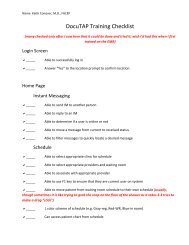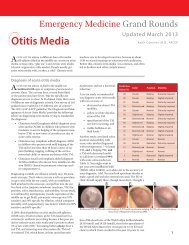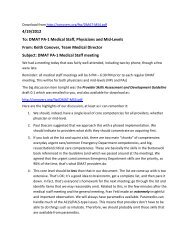Ticks Outline 1. Meet the Ticks 2. Preventing Tick Attachment 3 ...
Ticks Outline 1. Meet the Ticks 2. Preventing Tick Attachment 3 ...
Ticks Outline 1. Meet the Ticks 2. Preventing Tick Attachment 3 ...
You also want an ePaper? Increase the reach of your titles
YUMPU automatically turns print PDFs into web optimized ePapers that Google loves.
<strong><strong>Tick</strong>s</strong> <strong>Outline</strong><strong>1.</strong> <strong>Meet</strong> <strong>the</strong> <strong><strong>Tick</strong>s</strong><strong>2.</strong> <strong>Preventing</strong> <strong>Tick</strong> <strong>Attachment</strong>3. Removing <strong><strong>Tick</strong>s</strong>4. Lyme diseasea. Lyme Ecologyb. Clinical Lyme Diseasec. Tests for Lyme diseased. Treatmente. Lyme Controversy and Quackery (especially in Pennsylvania)5. O<strong>the</strong>r <strong>Tick</strong>-Associated Diseasesa. Anaplasmosis (Ehrlichiosis)b. Babesiosisc. Rocky Mountain Spotted Fever6. <strong>Tick</strong> paralysis<strong><strong>Tick</strong>s</strong> Educational Objectives<strong>1.</strong> Name at least of <strong>the</strong> three most medically-important ticks in North America, and at leastone disease that it may transmit to humans<strong>2.</strong> Name at least one highly-effective repellent effective against ticks.3. Differentiate recommended vs. non-recommended methods for removing ticks.4. Give criteria for clinical diagnosis of Lyme Disease, and give <strong>the</strong> standard drugtreatment indicated.5. Give reasons why acute care Lyme testing is seldom if ever appropriate, and why“chronic Lyme disease” should never even be entertained as a diagnosis.<strong><strong>Tick</strong>s</strong> Objectives Details<strong>1.</strong> Ixodes scapularis, <strong>the</strong> deer tick or black-legged tick (Lyme disease, anaplasmosis andbabesiosis); Dermacentor variabilis, <strong>the</strong> American dog tick (Rocky Mountain SpottedFever, tularemia and anaplasmosis); Amblyomma americanum, <strong>the</strong> lone star tick(STARI or Master’s disease).
<strong>2.</strong> DEET, Picaridin, and Repel on skin are all highly-effective. Permethrin on clothing ishighly-effective.3. Gently but firmly pulling on <strong>the</strong> neck of <strong>the</strong> tick with forceps or some similarcommercial device recommended; twisting, burning, suffocating or shooting <strong>the</strong> tick isnot recommended.4. A red rash >2” diameter at <strong>the</strong> site of a tick bite, or, within two weeks after a tick bite,any disseminated red rash not o<strong>the</strong>rwise firmly diagnosed, or any febrile illness noto<strong>the</strong>rwise firmly diagnosed, should be treated with a course of oral doxycycline or anaccepted alternate.5. Lyme titers take a month to rise, and <strong>the</strong>re are many false positives from old disease;<strong>the</strong>re is no association between fibromyalgia or chronic fatigue and evidence of priorLyme infection, and thus, no “chronic Lyme Disease.”



